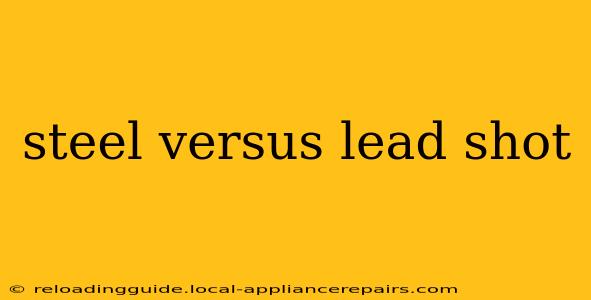Choosing the right shot for your firearm can significantly impact your shooting experience and results. For many years, lead shot reigned supreme, but steel shot has increasingly gained popularity, driven by environmental concerns and legal restrictions. This comprehensive guide delves into the key differences between steel and lead shot, helping you make an informed decision based on your specific needs and preferences.
Key Differences Between Steel and Lead Shot
The most significant difference lies in the density of the materials. Lead is considerably denser than steel, meaning lead shot packs more weight into a smaller volume. This leads to several downstream effects impacting performance and application.
Density and Pattern Density:
- Lead: Higher density translates to tighter patterns at longer ranges, resulting in more consistent shot placement. This is particularly crucial for hunting game at distance.
- Steel: Lower density means steel shot requires higher velocities to maintain pattern density at longer ranges. This can sometimes lead to less consistent patterns, especially compared to lead at similar ranges.
Hardness and Barrel Wear:
- Lead: Lead is a relatively soft metal. While it deforms upon impact, it's gentler on firearm barrels.
- Steel: Steel is significantly harder. This hardness can lead to increased barrel wear over time, particularly with older shotguns not designed for steel shot. Using steel shot in unsuitable firearms can cause serious damage.
Cost:
- Lead: Generally less expensive than steel shot.
- Steel: Typically more expensive than lead shot, although price differences vary depending on the type and size of shot.
Environmental Impact:
- Lead: Lead shot is toxic to wildlife and the environment. Its use is restricted or banned in many areas for waterfowl hunting.
- Steel: Steel is a non-toxic alternative, making it a more environmentally friendly choice. This is a major driving factor behind its increased adoption.
Steel Shot: Advantages and Disadvantages
Advantages:
- Environmentally friendly: Steel is a non-toxic alternative to lead, protecting wildlife and ecosystems.
- Suitable for waterfowl hunting: In many jurisdictions, steel shot is mandatory for waterfowl hunting.
- Generally harder: Steel shot offers better penetration in certain situations, although this can be a disadvantage in others.
Disadvantages:
- Lower density: Results in less dense patterns at longer ranges compared to lead.
- Higher cost: Typically more expensive than lead shot.
- Potentially higher barrel wear: Requires firearms designed for steel shot to avoid damage.
Lead Shot: Advantages and Disadvantages
Advantages:
- Higher density: Produces tighter patterns at longer ranges, leading to more consistent shot placement.
- Lower cost: Generally more affordable than steel shot.
- Less barrel wear: Gentler on firearm barrels.
Disadvantages:
- Toxic to wildlife and the environment: Its use is restricted or banned in many areas.
- Not suitable for waterfowl hunting (in many areas): Legal restrictions often prohibit its use for waterfowl.
Choosing the Right Shot: A Practical Guide
The best choice between steel and lead shot depends entirely on your specific needs and the regulations in your area. Consider the following factors:
- Target species and distance: Lead shot generally offers better performance for longer-range hunting, while steel is suitable for closer-range scenarios.
- Local regulations: Check hunting regulations and restrictions on lead shot in your area.
- Firearm compatibility: Ensure your firearm is compatible with steel shot before using it. Consult your firearm's manual for guidance.
- Budget: Steel shot is typically more expensive than lead.
By carefully considering these factors, you can select the appropriate shot for a safe, effective, and responsible shooting experience. Always prioritize safety and adhere to all relevant laws and regulations.

